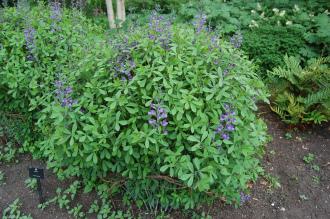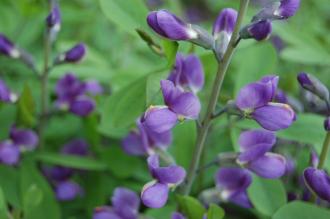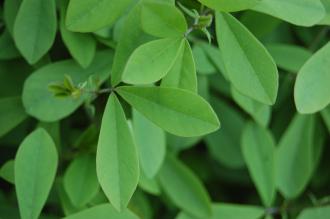
Baptisia ‘Purple Smoke’ (22/05/2016, Kew Gardens, London)
Position: Full sun to partial shade
Flowering period: Spring
Soil: Moist, well drained
Eventual Height: 1.2m
Eventual Spread: 90cm
Hardiness: 4a, 4b, 5a, 5b, 6a, 6b, 7a, 7b, 8a, 8b, 9a, 9b
Family: Papilionaceae or Fabaceae
Baptisia ‘Purple Smoke’ is a deciduous shrubby perennial with a clump forming habit. Its mid green leaves are trifoliate. Its leaflets are ovate with entire margins. Its violet flowers appear as terminal racemes which are up to 30cm long and above its leaves. Its dark gray fruit are cylindrical bean like pods and up to 6cm long. Its left undisturbed this plant forms a tap root.

Baptisia ‘Purple Smoke’ Flower (22/05/2016, Kew Gardens, London)
Baptisia ‘Purple Smoke’, commonly known as False Indigo, is is a cross between Baptisia australis and Baptisia alba.
The etymological root of the binomial name Baptisia is derived from the Greek baptos meaning ‘dyed’, in reference to its historic use as a dye.
The landscape architect may find Baptisia ‘Purple Smoke’ useful as a free flowering perennial. Once established this plant is drought tollerant. This plant may open up after flowering, staking may be used to help prevent this.

Baptisia ‘Purple Smoke’ Leaf (22/05/2016, Kew Gardens, London)
Ecologically, Baptisia ‘Purple Smoke’ flowers are attractive to pollinating insects, including butterflies.
Baptisia ‘Purple Smoke’ prefers moist, fertile, well-drained soils. It tolerates most pH of soil, although it prefers a slightly acid soil. It will tolerate poor soils.
Baptisia ‘Purple Smoke’ requires little maintenance. Large clumps may be dived every 4 to 5 years.

Landscape Architecture

